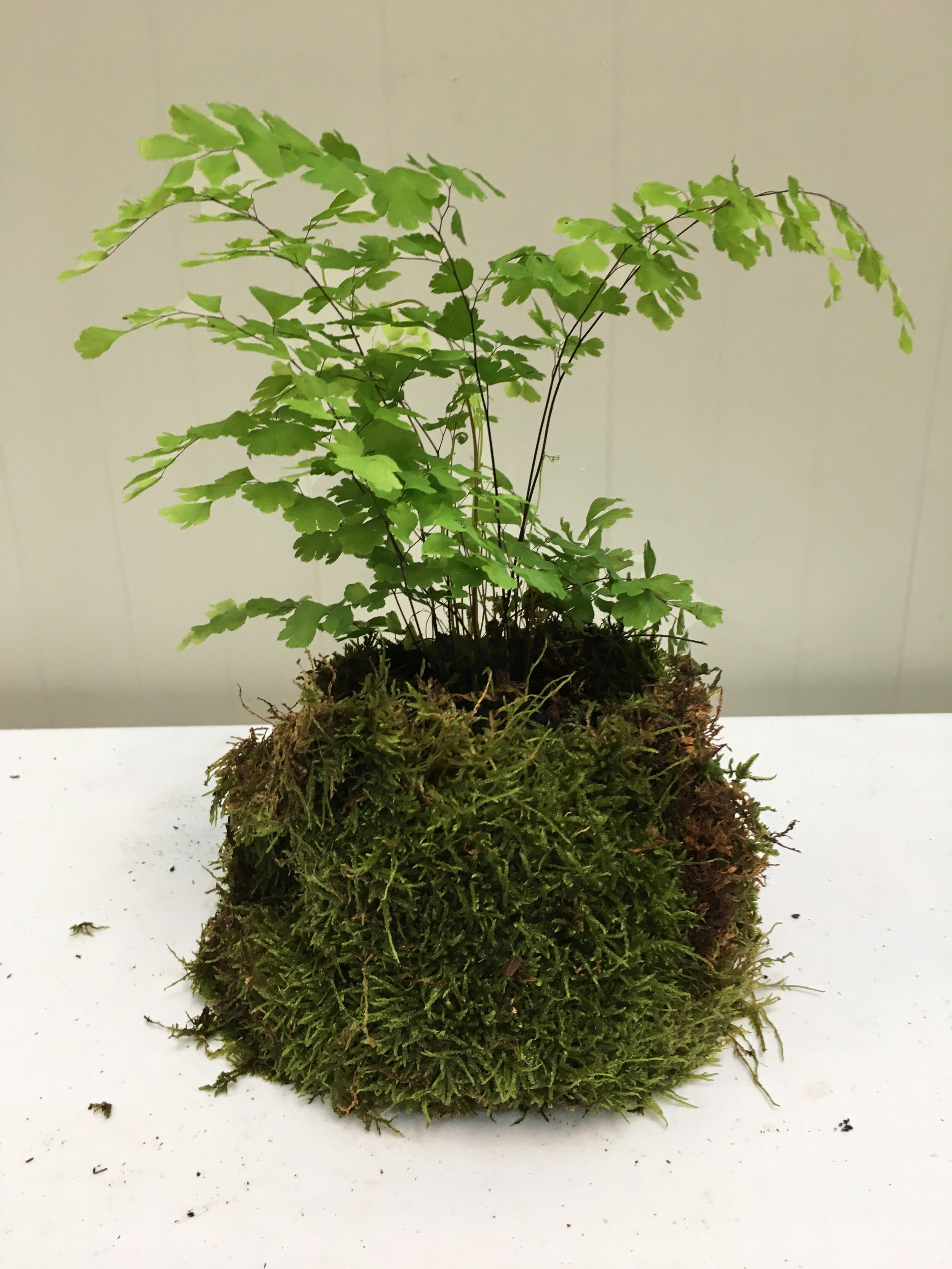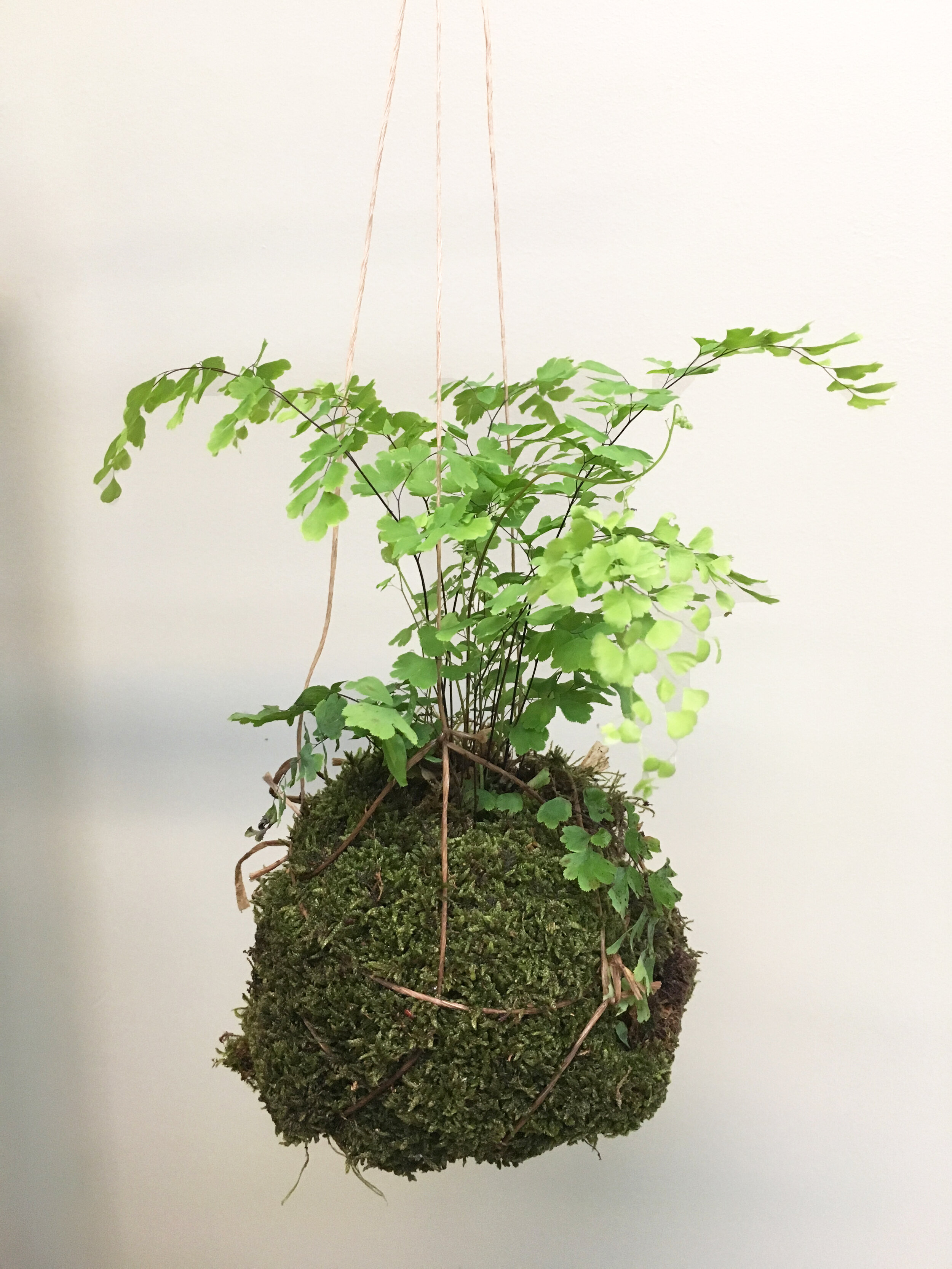The display of houseplants through the sculptural form of Kokedama has become increasingly popular, and it’s not surprising, for these pieces of living art are versatile and can transform any office or home into a tropical oasis.
The Japanese word ‘Kokedama’ translates to “moss ball” and is an ancient gardening tradition that can incorporate a wide variety of houseplants. The distinctive round shape of Kokedama is formed by covering the roots of the chosen plant with moss. The result can be displayed sitting on a decorative saucer or hanging from the ceiling. Creating these beautiful displays is fun and easy! Follow along to create your own Kokedama. Let’s get started!
Materials
For this project you will need:
- Sheet or Loose Sphagnum Moss
- One 4-inch plant (see below for suggestions)
- Scissors
- Small container or bucket to hold water
- Small container of Potting Soil
- Jute, twine, raffia twine with embedded wire, or small gauge monofilament
Choosing the Right Plant
Kokedama are living pieces of decorative art and it’s best to choose plants that are slower growing with smaller root systems so they will be happier long term. Many houseplants can be sculpted into Kokedama, and you will want to choose the right plant to thrive in the light conditions of your home or office. Here are some suggested plants:
These houseplants are great for medium to low light:
Dracaena (Dracaena spp.)
Pothos (Pothos spp.)
Snake Plant (Sanseveria spp.)
Peace Lily (Spathipyllum spp.).
There are many plants to choose from if your home has bright indirect light. Here are some of our favorites:
Maidenhair Fern (Adiantum spp.)
Birds Nest Fern (Asplenium spp.)
Bromeliad (Bromeliad spp.)
Spider Plant (Chlorophytum spp.)
Trailing Ivy (Hedera spp.)
Hoya (Hoya spp.)
Staghorn Fern (Platycerium spp.)
Inch Plant (Tradescantia spp.)
Pictured from left to right: Maidenhair Fern (Adiantium spp.), Peperomia (Peperomia spp.), and Spider Plant (Chlorophytum spp.)
Cacti and succulents can also be sculpted into Kokedama, although the loose, sandy mixture of Cactus Soil can be a bit more challenging to shape into a ball. If choosing to create a succulent Kokedama, substitute Cactus Soil instead of traditional potting soil.
If you have questions about the light needs of a plant or if it would be ideal for Kokedama, we would be happy to help when you visit or you can reach out to us on social media using #heyswansons.
Creating the Kokedama
Soak Your Moss
After gathering your supplies and choosing your plant, the next step is soaking the moss. The moss can be placed in a container filled with water and allowed to soak until thoroughly saturated. This may take 10 to 15 minutes.
Form a Soil Ball
While the moss is soaking, pour a handful of potting soil onto your table and slowly add water until the soil holds together when pressed firmly into a sphere shape. If the mixture becomes too muddy, it’s okay, simply add a bit more potting soil. The goal is to create a sphere of soil that stays together and doesn’t crumble. Next, remove the plant from the plastic pot and gently shake off any loose soil from the roots. Then, place some of the damp potting soil around the root ball and shape it into a sphere.
Wrap your Plant
After the root ball has been shaped, remove the moss from the container of water and lay on your table with the green side down. You will want to create a square or rectangular shape with the moss, as this will be wrapped around the root ball. Place the plant in the center of the moss and wrap around the root ball, trimming off any excess moss if needed.
Measure out about two arm lengths of your chosen thread, jute, twine, etc… and starting with one end of the twine, tie a loop around the top of the ball and secure with a double knot. Then wrap the remaining length of string in random directions around the ball to secure the moss. When you’re at the end of the string, tie it off on a nearby string on the ball. More string can be added to further secure the moss. It may be challenging to hold everything together, but the goal is to wrap the twine around the ball to keep the moss in place.
Soak Your Kokedama
Once the plant is completely wrapped, extra twine can be added if you choose to hang your Kokedama. The final step is to fill a bowl, bucket or sink with water and let the Kokedama soak until thoroughly saturated, about 5 to 10 minutes. After soaking, allow it to sit in a dish drainer or colander and so excess water can drain before sitting in a saucer or hanging. All done!
Caring for Your Kokedama
Watering
Watering your Kokedama is an easy and straightforward task, but how do you know when to water? The easiest way know is to feel the weight of the Kokedama. When the Kokedama feels light and the moss is dry, those are good indications it’s time to water. To water your Kokedama, fill a bowl, bucket or sink with water and soak for about 5 to 10 minutes or until thoroughly saturated. The moss ball should feel heavy after soaking. Then allow the Kokedama to drain before returning to its original location. The size and type of plant within the moss ball, air temperature, light, and other factors can influence how often the Kokedama needs water.
Fertilizing
Fertilize your Kokedama by using half the recommended concentration of a water-soluble indoor plant fertilizer when soaking your Kokedama. Follow the container instructions to determine how often to fertilize.
Light
The amount of light needed for your Kokedama can vary depending upon the type of plant. Houseplants such as Spider Plants, Ferns, Bromeliads, and Hoyas prefer sitting or hanging where they get lots of bright indirect light. Plants such as Pothos, Snake Plant, Dracaena, Peace Lily, and Trailing Ivy can tolerate areas with less light in your home or office. It’s best to reference the light conditions of the plant when choosing where to display your Kokedama.
Repotting
Kokedama is a transitory display style and your plant may eventually outgrow its moss ball. This is why we often choose slow-growing plants. To keep your Kokedama going longer, you can trim roots as you see them beginning to grow through the moss. Eventually, you can transplant the plant into a container and create a new Kokedama with a smaller plant.






